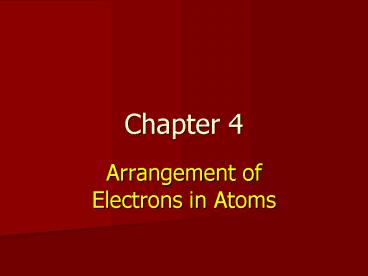Arrangement of Electrons in Atoms - PowerPoint PPT Presentation
1 / 33
Title:
Arrangement of Electrons in Atoms
Description:
Photoelectric effect: Emission of electrons from metal. When light shines ... Photoelectric ... the photoelectric effect. Ground State: Atom in its lowest energy state. ... – PowerPoint PPT presentation
Number of Views:47
Avg rating:3.0/5.0
Title: Arrangement of Electrons in Atoms
1
Chapter 4
- Arrangement of Electrons in Atoms
2
RUTHERFORD MODEL
3
CONCLUSIONS
- The atom contains a dense center called the
nucleus. - The nucleus contains a positive charge and most
of the mass of the atom. - The nucleus is approximately 100,000 times
smaller than the atom.
4
CONCLUSIONS
- The nucleus is positively charged. The amount of
positive charge balances the negative charge of
the electrons. - The electrons move around in the empty space of
the atom surrounding the nucleus.
5
Incomplete Model
- Did not explain where the electrons are located
in the space surrounding the nucleus. - Investigations into the absorption and emission
of light by matter led to a new atomic model - Studies revealed a relationship between light and
an atoms electrons.
6
Dual Nature of Light
Electromagnetic radiation exhibits 1) Wave
Properties 2) Particulate Properties
7
Electromagnetic Radiation
- Radiant energy that exhibits wavelength-like
behavior and travels through space at the speed
of light in a vacuum.
8
Classification of Electromagnetic Radiation
9
Waves
- Waves have 3 primary characteristics
- 1. Wavelength distance between two peaks in
a wave. - 2. Frequency number of waves per second
that pass a given point in space. - 3. Speed speed of light is
- 3.0 ? 108 m/s.
10
The Nature of Waves
11
Wavelength and frequency can be interconverted.
- ? c/?
- ? frequency (s?1)
- ? wavelength (m)
- c speed of light (m s?1)
Inverse Proportion.
12
Calculate the wavelength of radio waves broadcast
from an FM radio station at 98.5 MHz.
- c ? ?
- c/ ?
- 3.0 x 108 m/s ? 98.5 x 106 s-1
- 3.0 meter
13
Particle Description of Light
- First arose due to the observation of the
- Photoelectric effect
- Emission of electrons from metal
- When light shines on the metal.
- Requires light with a certain minimum
- Frequency.
- See Figure 4-3 on page 93.
14
Wave theory would have predicted that light of
any frequency could supply enough energy to
eject an electron.
15
Max Planck (early 1900s)
- Studied emission of light by hot objects.
- Proposed objects emit energy in small specific
amounts called Quanta. - Quantum minimum quantity of energy
- that can be lost or gained by an atom.
16
Plancks Constant
Transfer of energy is quantized, and can only
occur in discrete units, called quanta.
- ?E change in energy, in J
- h Plancks constant, 6.626 ? 10?34 J s
- ? frequency, in s?1
- ? wavelength, in m
17
Surprise! Energy seems to have particle-like
properties!
18
Albert Einstein
- Proposed the dual wave-particle nature of light.
- Light exhibits many wave-like properties, but
also can be thought of as a stream of particles. - Light is composed of a stream of Particles called
Photons.
19
Electromagnetic Radiation
20
- Photon A particle of electromagnetic
- radiation having zero mass and
- carrying a quantum of energy.
Energy of a photon E h? h c/?
21
Photoelectric Effect
- To emit or eject an electron from a metal, the
electron must be struck by a photon with a
certain mim. Energy to knock that electron loose. - If the photon energy is too low, the electrons
remain bound to the metal surface.
22
Electrons in different metals, are bound more or
less tightly, Therefore, different metals
require different mim. Frequencies to
exhibit the photoelectric effect.
23
Ground State Atom in its lowest energy state.
Excited State Atom with a higher
potential Energy.
24
A Change between Two Discrete Energy Levels
25
Atomic Spectrum of Hydrogen
- Continuous spectrum Contains all the
wavelengths of light. - Line (discrete) spectrum Contains only some of
the wavelengths of light.
26
A Continuous Spectrum (a) and A Hydrogen Line
Spectrum (b)
See also Fig. 4-6 Page 95.
27
- Emission Spectrum of each element
- is Unique.
- Can be used to identify samples.
- Can help determine components of
- the stars.
28
BOHR MODEL
29
Niels Bohr
- Developed Quantum Model for the Hydrogen Atom.
- Model could explain the observed line emission.
- The Electron in a Hydrogen Atom moves around the
nucleus only in certain allowed circular orbits.
30
Bohr Model
- Lowest energy state
- electron is in the orbit closest to the
nucleus. - Higher energy states
- electron is in orbits that are successively
farther from the nucleus.
31
Electronic Transitions in the BohrModel for the
Hydrogen Atom
32
(No Transcript)
33
- Bohr Model
- successful in explaining the spectral
- Lines of hydrogen
- did not explain spectra of atoms
- With more than one electron.
- did not explain the chemical
- behavior of atoms.































